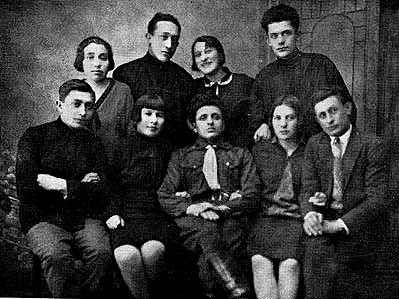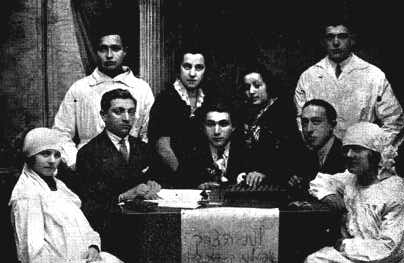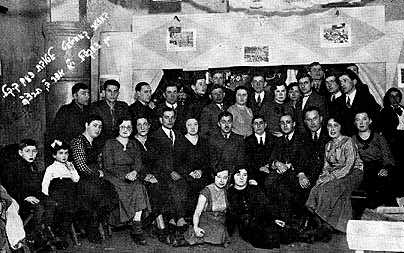
|
|
[Page 81]
Same article appears in Hebrew on pages 78 through 80.
Our shtetl, Dokshitz, was no different than the other shtetls in the czarist occupied territory or in the rest of Poland.
Dokshitz was attractive, despite its wooden houses and the four broad long streets. In the center - the market with its shops.
The spiritual center of the shtetl was mostly at the synagogue-courtyard - five houses of worship in a row. Near them - the bath and the mikveh [ritual bathhouse] by the river.
All religious teachers and their schools could be found by the synagogue-courtyard. The ritual slaughterer, Reb Yoykhenen Gordon - a dear man, and the scribe also lived there.
I remember everything, all that went on in the Beys-Hamidresh [religious house of study] and in the four shtibelekh [small houses of worship or prayer rooms] of the Chabbad-Lubavitsh Hassidim. Some four-five minyans [prayer groups] prayed there regularly during the week, from the very crack of dawn on.
I remember the Sabbaths and the holidays, the nights of slikhos [the days preceding the Jewish High Holidays] and the eve of Yom Kippur.
I remember the large place encircled by a high fence. There used to be a synagogue there that burned down in one of the fires.
Bride and groom under the wedding canopy and Klezmer musicians, even from distant places, were brought there. The whole shtetl, invited and not invited, took part in accompanying the couple to this holy place.
I remember how Jewish children in the shtetl would leave the schoolrooms on winter nights with little lanterns in hand. And on slikhos nights people streamed in to the synagogue courtyard from all directions.
The Hoshana-Raboh [the last of the intermediate days of the festival of Sukkes/Tabernacles] night in synagogue is deeply engrained in my memory: or walking with kapores [traditional object for symbolically ridding self of sins, often a chicken/fowl] in hand on the eve of Yom Kippur: carrying all of the utensils every Passover eve to fire them and make them kosher for Passover in the big pot near the bath.
Tisha B'av [the ninth day of the Jewish month of Av, a day of fasting, commemorating the destruction of the first and second temples] left the strongest impression on me. The group of people walking to the cemetery after saying Kinos [lamentation poems] in synagogue - men, children and women.
I remember you, my shtetl, at the end of the First World War, when soldiers of newly freed Poland suddenly appeared on horseback -
For a long time I could not forget that image. My father was thus caught and I followed as they took him. I swore to myself that I would defend my father if they dared to lay their hands on him - and it would be what it would be.
The Poles were the ones who gave me the idea to leave the accursed Diaspora and take part in the building of The Land [of Israel].
Until the final years of the First World War, people in Dokshitz didn't know of the existence of a national Jewish movement, about Zionism. Of the first who began to do something was Lipeh Levitan, blessed be his memory, a child from a wealthy family, he was an intelligent, nice and healthy young man. He succeeded in organizing several boys and girls and founding a Zionist

The Hassidim in Dokshitz related negatively to Zionism, as did all orthodox Jews. When people heard about the Balfour Declaration they did not want to rejoice at all and they referred to it as the Balfour Tsoreh [plight/sorrow/woe]. When the British Mandate over Palestine was approved, some Zionist inclined people wanted to recite Psalms and a prayer of rejoicing - there was a strong opposition.
Lipeh worked on me as well. I was jealous of him. I was too young though and had to withstand regular interference from my father.
At that time the first Hebrew teacher came to Dokshitz - Presman. A dear person, the son-in-law of Reb Binyomin-Meyer Tomarkin, blessed be his memory, a good Jew who had influence in the shtetl. He opened the first Hebrew school in Dokshitz, despite the tremendous opposition from the extreme Hassidim. That school brought out a Zionist-Nationalist breath in the shtetl. The youth began to sing Hebrew songs. From time to time there were also Hebrew presentations - but with the Ashkenazic pronunciation.
That school also gave us good students, from whom there later became organizers and members of Hekhalutz and Hashomer Hatza'ir, who went for Hakhshara and later made aliyah.
After Presman came, his brother-in-law, Tomarkin, who did much in the field of Hebrew education, not the least of which was raising a generation in the national spirit. In those times long and interesting letters form Lipeh in the Land of Israel would arrive, in which, in a beautiful spirited style, he described the new colonization in the Jezreel Valley and in the Galilee.
With talent, he described his visits to places mentioned in the bible, about which we studied in kheyder. Those descriptions delighted the hearts of young and old. Lipeh's letters were passed from hand to hand and blew life into dry bones....
[Page 84]
After Lipeh, I became the second to organize the "Hekhalutz." I was not as successful as he. Individuals followed his example and after me, only two came to this country. After my aliyah, in 1924, the students in the Hebrew school became active, particularly Khayem Solovey and Shmuel-Leyb Kaplan, blessed be his memory.
Shmuel-Leyb was loyal and devoted to the Zionist ideal. For all the years until his death, he was the representative of the Palestine-office in Dokshitz. He helped every person making aliyah, every khalutz [pioneer] from his first step to actually making aliyah. Various obstacles and reasons did not allow for his making aliyah himself. He was like the dear loyal ship captain who helped save lives until the final day, when World War II broke out. His place is with all of the holy and pure of Dokshitz's Jewry.
Since my leaving the shtetl in 1924, I have aspired to se it again - but have not had the honor.
Professions and Good Deeds of Dokshitz Jews
From what did our Dokshitz Jews actually live and earn a living? One need not do any tremendous research to find the answer. This is simply because in those times in Jewish shtetls in Poland all of our Jewish brethren lived thusly.
Mainly Jews were in trade, some on a greater and some on a lesser scale. Whatsoever was purchasable was bought from peasants in the area: dry mushrooms, hides for fur coats, pig hair, wheat, flax. People also leased plots of forest from neighboring gentiles for copping wood and leased mills to mill the wheat. There were also fishermen, butchers, who traveled throughout the villages all week buying living cows, slaughtering them in the slaughterhouse and providing the shtetl with meat. There were also Jews who worked their own fields.
Most Jews were tradesmen, toiling people, who labored hard and bitterly to earn their piece of bread. Behind the city good blacksmiths served the area, shoeing horsed, fixing wagons. They stood all day by the anvil and bellows. Carpenters built beautiful works with simple tools, even luxury furniture, doors and windows. There were also glaziers, tinsmiths, locksmiths, tailors and milliners. The latter sold their own work in shops or booths in the market.
Tuesday was the weekly market - the day when all looked to make a weeks earnings. There were bookbinders who had to read through each book first. People worked hard, the women also helped in the trade. It is a fact that there was no eight-hour workday - people worked late into the night.
There were photographers, thanks to whom photos of the shtetl remain.
Tailors were in different categories: simple, who sewed for the peasants [in the shtetl] and also the peasants in the village; tailors who sewed better clothes for Jews or military people and officers. (Among the so-called village-tailors was my grandfather, Moyshe-Yerakhmiel Gilenson. A simple Jew, not
Quite early on a Sunday, he could be seen on his way with his tallis [prayer shall] and tefillin [phylacteries] and a few sundry items in a little sack hanging on a stick. A cigarette stuck to his bottom lip. Thus he would be off for a whole week - to sew a fur for someone by hand, or clothing form crude fabric, which the peasants made themselves.
Friday afternoon my grandmother and the grandchildren would meet him as he returned home. There was tremendous joy. He had a gift for everyone. He would return by horse and wagon from the peasants where he worked and he would be loaded with all good things: rye for flour, potatoes. A live chicken and fruits - that's the kind of man my grandfather was.
Jews worked hard all week. But on Shabbes [Sabbath] they all used to go out in the street for a stroll. People talked about everyone and everything.
The tradesmen later organized themselves in an artisans union. The originators were: Max Golts - the photographer, Shmuel Kugel - the bootmaker, Khayem-Rafoel Gilenson, Yitzkhok-

[Page 88]
There was a second organization - a specific Dokshitz accomplishment called "Poaley Tzedek" [Workers of Righteousness]. The mission was to help the needy, particularly during the time of illness. The medical help was at a lower level at that time. They purchased glass cups [for bloodletting], thermometers, hot water bladders, ice-bladders. In the summer they prepared ice in Gordon's beer brewery, the so-called "Liyednik" [summer visitor].
Reb Yoel, Der Kurtzer [the short one] and his wife did all of this work. People called him "the short one" because of his short height, although he had a great soul. More than once he was awakened in the middle of the night. He was always ready to help the sick.

|
|
JewishGen, Inc. makes no representations regarding the accuracy of
the translation. The reader may wish to refer to the original material
for verification.
JewishGen is not responsible for inaccuracies or omissions in the original work and cannot rewrite or edit the text to correct inaccuracies and/or omissions.
Our mission is to produce a translation of the original work and we cannot verify the accuracy of statements or alter facts cited.
 Dokshitz, Belarus
Dokshitz, Belarus
 Yizkor Book Project
Yizkor Book Project
 JewishGen Home Page
JewishGen Home Page
Copyright © 1999-2024 by JewishGen, Inc.
Updated 19 Feb 2003 by LA